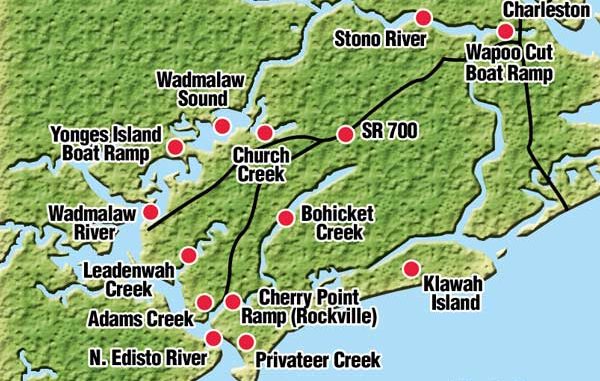
Avoid the crowds and fish the marshes south of Charleston for great November trout action.
It didn’t take much coaxing for Rawling Pratt-Thomas and Rob Bennett to head for home from when it came time to really get down to the business of guiding fishermen around Charleston’s inshore waters.
Pratt-Thomas practically grew up on Leadenwah Creek, which winds across Wadmalaw Island before emptying into the North Edisto River. And Bennett was basically raised on Bohicket Creek, an even bigger tributary of the same river that blazes a trail through almost the same area. So the marshes between Charleston and Edisto are a no-brainer.
But besides being on “home” waters — and waters that are full of fish — the other big draw was something that was missing: other fishermen.
In November, when fishing for speckled trout reaches its peak, the two guides expect to fish where they want to, when they want to, with little interference from other boats.
No pulling up to fish an oyster point and finding someone already anchored on the best spot. No worrying about having to keep secret spots a secret. No chance of having to fool wary trout that have been beaten to death with lures and bait all year.
“You know, I might fish all day and not see another flats boat,” said Pratt-Thomas, who operates Charleston Inshore Fishing Charters (843-834-1061). “That’s absolutely the reason I fish down here — nobody else does.”
“There’s just nobody down here. I’m usually fishing all by myself,” said Bennett, of Lowcountry Inshore Charters (843-367-3777).
So the fish are unpressured, and you’ve got miles and miles of water all to yourself. If that wasn’t enough to send you up the Stono River or across James Island and Johns Island, away from Charleston Harbor and the boats that are lined up to fish good spots every weekend and most weekdays, then there’s the matter of how good the fishing is.
“As far as numbers, we have as many trout as they do up in the Wando River and up that way around Charleston,” Pratt-Thomas said. “We’ve got a load of fish — and we don’t have the fishing pressure. It’s difficult to get to a lot of the places we fish by car.”
At the Cherry Point Ramp on Bohicket Creek near Rockville, there wasn’t another boat and trailer in sight when Pratt-Thomas picked up one of his guide parties last November. He ran to the Wadmalaw River, the Wadmalaw Sound, the Stono River — fishing a dozen or so spots without seeing another boat. And when two of those spots wound up being full of 18-inch speckled trout, the trip back seemed a lot shorter and more enjoyable — with a full cooler.
That’s the kind of action that Bennett said is par for the course in November — possibly the best month to fish for specks.
“There will be big numbers of nice fish this month,” he said. “We catch a lot of small specks in September, but when October and November come around, there are no more small fish; they’re all keepers.
“And toward the end of October, when the shrimp start to leave, those trout will really start to bite. They’re feeding on those shrimp, and then the shrimp start to move out, and you put something in front of them, and they’ll kill it.”
Pratt-Thomas, who cut his teeth fishing with the late Gene Tweed, a legendary angler from Hollywood — a town near Wadmalaw Sound, not in California — agreed that the last two weeks of October, all the way through early December, is the one time to be on the water if you only have one time.
“Around the middle to the end of October, our fishing will be picking up,” Pratt-Thomas said. “It will be fantastic. The trout are going crazy for the shrimp, and the shrimp will start moving out; they’ll start moving toward the inlets, and by mid-November, they’ll be gone. And the fish will be looking for anything to hit.”
The fishing is so good, Pratt-Thomas and Bennett can take totally divergent paths and catch the same fish. Pratt-Thomas fishes live shrimp or plastic shrimp imitators under a Cajun Thunder cork. Bennett will use a cork, but it will be a standard 3-inch panfish cork he can clip onto his line and adjust easily. But he won’t stay with the cork long; as soon as the shrimp start to thin out, he’ll go with a leadhead jig and a curlytail grub. And Pratt-Thomas keys on the high end of the tide cycle, while Bennett murders them when the water is on the low ebb — unusual for a trout killer.
“For every stage of the tide, I’ve know some places I can go where there should be some trout,” Bennett said. “I personally like the last two hours of the outgoing tide and the first three hours of the incoming tide the best. I hate fishing on a high tide — I think they get spread out too much.”
Wherever and however they choose to ply their trades, a basic agreement exists: when you find specks this month, they’re likely to be big schools, and they’re likely to be hungry.
“I want to be fishing little creeks and little gutter creeks with clean, moving water,” said Pratt-Thomas. “This is the time when you can go so far up a little gutter creek that your boat hardly fits and catch fish. You can’t do that any other time except October and November.
“On the last two hours of incoming tide, those trout will go all the way back up, and on the first three hours of outgoing tide, they’ll come all the way back out. You go as far as you can on the high tide, and when the tide starts out, that area is going to muddy up, and you’ll be pushed out. The trout will be moving exactly the same way you’ll be moving, to stay in the clean water.
“When you hit ’em, you should get a consistent 20-minute bite. You’ll might get seven, 10, 12 or 20 fish. Sometimes you’ll catch one or two bigger trout, but most of the trout you catch in one spot will be about the same size. A lot of times when you get on a bite, they’ll all be 16- or 17-inch fish. Sometimes, they’ll all be 13-inch fish. What I’ve learned is when you get on smaller fish, you either move, or sometimes you just fish deeper. The bigger fish may be down deeper.”
Pratt-Thomas’ favorite spots are off the Stono River and in Wadmalaw Sound. He said a big difference between the area south of Charleston Harbor and the extensive network of rivers, creeks, marshes and inlets north of the harbor is that the south end doesn’t have quite as many oysters, and the total amount of estuary — the grass flats back in the marsh — isn’t quite as big. That’s why finding creeks, points that the current runs up against, little drop-offs and other places that hold trout is more important. You just don’t work along any marsh edge and catch fish.
“You fish little drops and breaks, and you fish oysters around the mouth of creeks — anywhere with a good current, but not too much,” Pratt-Thomas said. “If you know where some oysters are, once they get flooded (on high tide), you’ll find little gutters of water moving around them, and you fish the lee side — that’s where the trout will all sit.”
Pratt-Thomas fishes live shrimp or a DOA shrimp under a popping cork, making long casts and working the bait with a series of jerks and twitches. Making the leader the right length is paramount to success.
“The color of the cork doesn’t matter; the length of the leader can be the key. A lot of people make it too short. You can change and fish it at different depths, as long as it’s not touching bottom,” he said. “You can be in 10 feet of water and catch ’em on a cork with 2½ feet of leader under it. They’ll hear it and look up and see that shrimp, and they’ll come eat it.”
Bennett fishes all over the area, from the inlet at the North Edisto River to Privateer Creek, then Bohicket Creek, Adams Creek, Leadenwaw Creek, Church Creek and the Stone River.
“The whole area is slam full of trout,” said Bennett, who’ll fish live shrimp under a cork before the shrimp start to leave — only he goes with a much simpler outfit than the popular pre-rigged popping corks.
“Everybody is all rigged up with their swivels and corks, and that’s fine, but this time of year, I’ll fish a shrimp under a 3-inch cork with a little lead on the bottom that you can clip on your line — the kind you fish for bream or crappie with,” he said. “I’ll use 14 to 16 inches of mono for the leader, tie on a swivel and a 2/0 Kahle hook and pinch on a quarter-ounce split shot about halfway up the leader from the hook. Then, I’ll just clip the cork on about 18 inches above the swivel.
“I can adjust it so easily. If I need to fish shallower, I can just slide it down. If I need to fish deeper, I can slide it up. I don’t need to retie all the time. Every cork I have rigged will be like that, and I’ve caught flounder, reds and trout on them.”
But Bennett’s real love is “grubbing” for specks, fishing 3-inch curlytail grubs on a quarter-ounce leadhead jig once the shrimp thin out and the specks are really fighting over whatever food is left.
“I don’t fish a grub under a cork; I know a lot of guys fish a DOA shrimp, but if I’m not fishing live shrimp under a cork, I’m grubbing,” he said. “I know people like to fish a paddletail grub, but I just love a curlytail. I think it has more action, and I want the fish to be able to see my bait.
“I’ll use two colors: electric chicken and smoke/glitter. I’m fishing 6½- to 7-foot Ugly Stik Lite rods with 6- to 8-pound mono. Fish can’t see that 6-pound test, and on a light rod, you can really feel them and it’s fun.
“I have threaded a mud minnow on the jighead and just took the end of the curlytail and threaded it onto the hook and caught ’em on that. The more flash you put down there, I think the more the fish like it.”

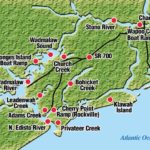
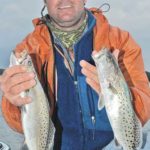
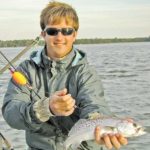
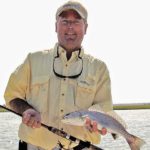
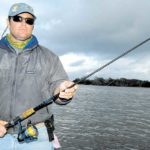
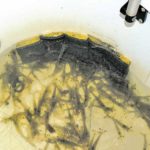



Be the first to comment